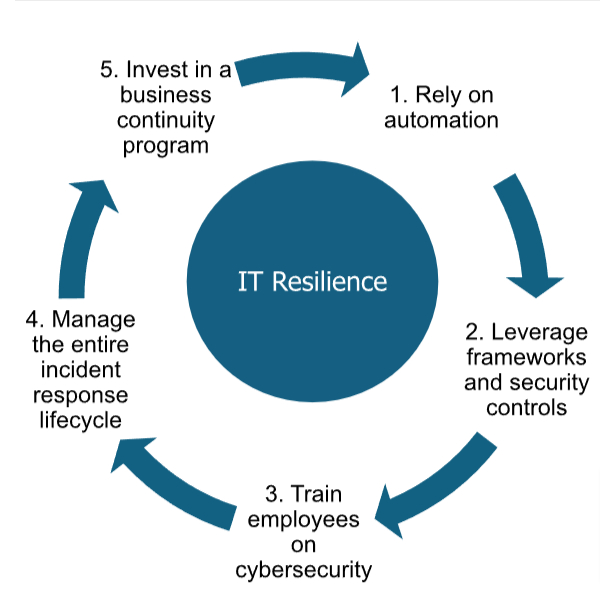Companies today are moving toward digitalization, enabling, and improving processes by leveraging digital technologies and digitized data. Such a move is tremendously efficient and helps companies build value. However, digitalization also leaves companies exposed to IT risk and vulnerable to cyber-attacks and ransomware.
Cyber threats keep the IT risk community on high alert. From attacks on healthcare organizations, government, businesses, and municipalities, ransomware is leaving almost no industry spared. Identity thieves exploit security weaknesses. Cybercrime is expected to cost the world $10.5 trillion annually by 2025.
Companies must do more to shore up their cyber defenses, from the IT department to the executive branch, from the remote workforce to the supply chain network.
Here are our five must-haves for IT security and operational resilience. The goal is to maintain operations while minimizing disruptions to vital computer networks.

- Rely on automation
One reason companies feel overwhelmed by cybersecurity is a shortage of IT professionals and resources. However, there are other options. For example, IT risk and cybersecurity software that maps risks to requirements, automates assessments of assets and third parties and improves compliance. With the right solution, you can do more to protect your company’s IT infrastructure with fewer resources.
- Leverage frameworks and security controls
Frameworks like the NIST CSF ISO 27001 for data protection, and CIS Security Controls help organizations accelerate their defences quickly and comply with regulations. The right framework and controls depend on your preference for prescriptive or descriptive models. Frameworks and controls can be housed and engaged from the right platform.
- Train employees on cybersecurity
Your employees are soft targets for cyberattacks. Phishing attacks, social engineering, and whale hunting all prey on human weaknesses. The trend to remote work feeds right into this major risk to organizations. Fortunately, awareness and training can equip workers to spot trouble and protect company information. Ensure employees also review and attest to policies on Internet usage, cybersecurity, and data ownership.
- Manage the entire incident response lifecycle
The previous items on the checklist have greatly reduced the risk of cyber incidents. However, incidents still occur. The best response is end-to-end. Modern incident management provides automated incident identification, response, and due diligence. Automation is faster, more accurate, and can take advantage of security rating services and managed XDR.
- Invest in a business continuity program
Create a cross-functional team to remove silos and address the overlaps between business operations, information security, and workforce, and workplace health and safety so that a crisis incident can be managed holistically. The ultimate goal is an integrated approach to operational resilience that leads to a business continuity program that incorporates IT risk, vendor risk, and anything that could disrupt operations.
That is our list of five must-haves for IT security and operational resilience. One cannot exist without the other. Addressing these five essential areas is the path to resilience and the way to profits and productivity.
This article was originally published by SAI360.






